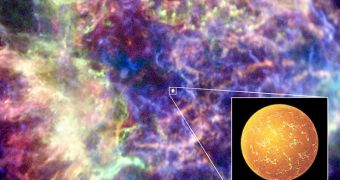Using telescope data spanning an entire decade, researchers have recently compiled a new dataset on how the renowned supernova remnant Cassiopeia A's neutron star is evolving over time. The celestial body is the youngest known such formation to date, and so peering into the interior of this super-dense star is something that astronomers are very keen on doing. Details of the long-term study were presented Thursday, April 15, at the RAS National Astronomy Meeting, held in Glasgow, Scotland, PhysOrg reports.
The presentation was made by University of Southampton astronomer Dr Wynn Ho and colleague Dr Craig Heinke, who is based at the University of Alberta, in Canada. The team used images collected between 2000 and 2009, using the NASA Chandra X-Ray Observatory, one of the American space agency's four Great Observatories. “This is the first time that astronomers have been able to watch a young neutron star cool steadily over time. Chandra has given us a snapshot of the temperature roughly every two years for the past decade and we have seen the temperature drop during that time by about 3 [percent],” Dr Ho told colleagues gathered at the meeting.
Neutron stars are the collapsed cores of former massive stars that did not have sufficient mass or did not experience the necessary conditions to become a black hole. They are composed of considerable amounts of elementary particles called neutrons, which are compressed together by the force of gravity at unimaginably-high pressures. This means that the matter at their cores has a density that is trillions of times higher than that of lead. Generally, astrophysicists say that neutron stars are produced following supernova explosions. In the case of Cassiopeia A, the explosion is thought to have occurred around the year 1680.
Scientists believe that the remnant core was initially heated up to billions of degrees Celsius, but add that today it only has a temperature of around two million degrees. ”Young neutron stars cool through the emission of high-energy neutrinos – particles similar to photons but which do not interact much with normal matter and therefore are very difficult to detect. Since most of the neutrinos are produced deep inside the star, we can use the observed temperature changes to probe what’s going on in the neutron star’s core,” Ho added.
“ The structure of neutron stars determines how they cool, so this discovery will allow us to understand better what neutron stars are made of. Our observations of temperature variations already rule out some models for this cooling and has given us insights into the properties of matter that cannot be studied in laboratories on Earth,” he further explained. A paper detailing the study was submitted to the esteemed publication Astrophysical Journal.

 14 DAY TRIAL //
14 DAY TRIAL //